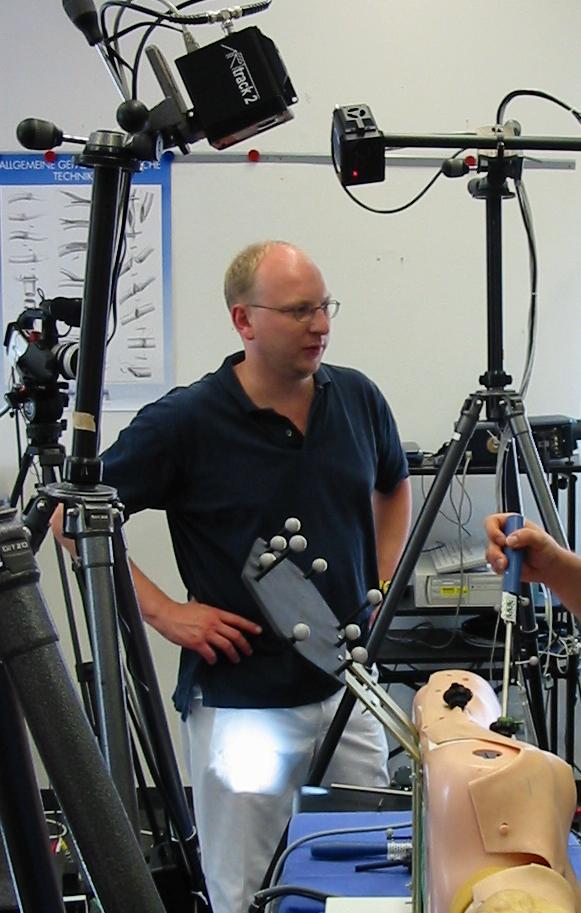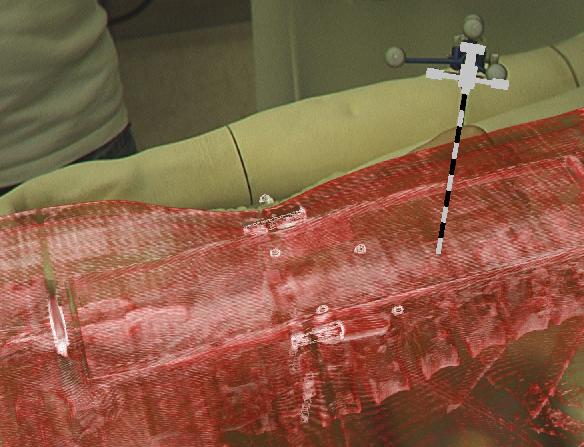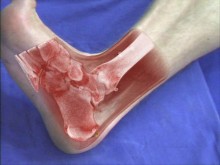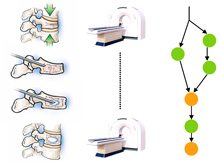| 2010 |
|
L. Wang, J. Traub, S. Weidert, S.M. Heining, E. Euler, N. Navab
Parallax-Free Intra-Operative X-ray Image Stitching
the MICCAI 2009 special issue of the Journal Medical Image Analysis
(bib)
|

|
M. Wieczorek, A. Aichert, O. Kutter, C. Bichlmeier, J. Landes, S.M. Heining, E. Euler, N. Navab
GPU-accelerated Rendering for Medical Augmented Reality in Minimally-Invasive Procedures
Proceedings of Bildverarbeitung fuer die Medizin (BVM 2010), Aachen, Germany, March 14-16 2010
(bib)
|

|
P. Dressel, L. Wang, O. Kutter, J. Traub, S.M. Heining, N. Navab
Intraoperative positioning of mobile C-arms using artificial fluoroscopy
SPIE Medical Imaging, San Diego, California, USA, February 2010
(bib)
|
| 2009 |

|
C. Bichlmeier, S.M. Heining, L. Omary, P. Stefan, B. Ockert, E. Euler, N. Navab
MeTaTop: A Multi-Sensory and Multi-User Interface for Collaborative Analysis of Medical Imaging Data
Interactive Demo (ITS 2009), Banff, Canada, November 2009
(bib)
|


|
T. Blum, S.M. Heining, O. Kutter, N. Navab
Advanced Training Methods using an Augmented Reality Ultrasound Simulator
8th IEEE and ACM International Symposium on Mixed and Augmented Reality (ISMAR 2009), Orlando, USA, October 2009, pp. 177-178. The original publication is available online at ieee.org.
(bib)
|

|
C. Bichlmeier, S. Holdstock, S.M. Heining, S. Weidert, E. Euler, O. Kutter, N. Navab
Contextual In-Situ Visualization for Port Placement in Keyhole Surgery: Evaluation of Three Target Applications by Two Surgeons and Eighteen Medical Trainees
The 8th IEEE and ACM International Symposium on Mixed and Augmented Reality, Orlando, US, Oct. 19 - 22, 2009.
(bib)
|

|
C. Bichlmeier, M. Kipot, S. Holdstock, S.M. Heining, E. Euler, N. Navab
A Practical Approach for Intraoperative Contextual In-Situ Visualization
International Workshop on Augmented environments for Medical Imaging including Augmented Reality in Computer-aided Surgery (AMI-ARCS 2009), London, UK, September 2009
(bib)
|
|
A. Ahmadi, N. Padoy, K. Rybachuk, H. Feußner, S.M. Heining, N. Navab
Motif Discovery in OR Sensor Data with Application to Surgical Workflow Analysis and Activity Detection
MICCAI Workshop on Modeling and Monitoring of Computer Assisted Interventions (M2CAI), London, UK, September 2009
(bib)
|

|
C. Bichlmeier, S.M. Heining, M. Feuerstein, N. Navab
The Virtual Mirror: A New Interaction Paradigm for Augmented Reality Environments
IEEE Trans. Med. Imag., vol. 28, no. 9, pp. 1498-1510, September 2009
(bib)
|
|
L. Wang, J. Traub, S. Weidert, S.M. Heining, E. Euler, N. Navab
Parallax-free Long Bone X-ray Image Stitching
Medical Image Computing and Computer-Assisted Intervention (MICCAI), London, UK, September 20-24 2009
(bib)
|

|
B. Ockert, C. Bichlmeier, S.M. Heining, O. Kutter, N. Navab, E. Euler
Development of an Augmented Reality (AR) training environment for orthopedic surgery procedures
Proceedings of The 9th Computer Assisted Orthopaedic Surgery (CAOS 2009), Boston, USA, June, 2009
(bib)
|

|
N. Navab, S.M. Heining, J. Traub
Camera Augmented Mobile C-arm (CAMC): Calibration, Accuracy Study and Clinical Applications
IEEE Transactions Medical Imaging, 29 (7), 1412-1423
(bib)
|
|
L. Wang, J. Traub, S.M. Heining, S. Benhimane, R. Graumann, E. Euler, N. Navab
Long Bone X-ray Image Stitching using C-arm Motion Estimation
Proceedings of Bildverarbeitung fuer die Medizin (BVM 2009), Heidelberg, Germany, March 22-24 2009
(bib)
|
|
L. Wang, S. Weidert, J. Traub, S.M. Heining, C. Riquarts, E. Euler, N. Navab
Camera Augmented Mobile C-arm: Towards Real Patient Study
Proceedings of Bildverarbeitung fuer die Medizin (BVM 2009), Heidelberg, Germany, March 22-24 2009
(bib)
|
| 2008 |
|
C. Bichlmeier, B. Ockert, S.M. Heining, A. Ahmadi, N. Navab
Stepping into the Operating Theater: ARAV - Augmented Reality Aided Vertebroplasty
The 7th IEEE and ACM International Symposium on Mixed and Augmented Reality, Cambridge, UK, Sept. 15 - 18, 2008.
(bib)
|
|
J. Traub, T. Sielhorst, S.M. Heining, N. Navab
Advanced Display and Visualization Concepts for Image Guided Surgery
IEEE/OSA Journal of Display Technology; Special Issue on Medical Displays, Volume 4, Issue 4, Dec. 2008
(bib)
|



|
O. Kutter, A. Aichert, C. Bichlmeier, J. Traub, S.M. Heining, B. Ockert, E. Euler, N. Navab
Real-time Volume Rendering for High Quality Visualization in Augmented Reality
International Workshop on Augmented environments for Medical Imaging including Augmented Reality in Computer-aided Surgery (AMI-ARCS 2008), USA, New York, September 2008
(bib)
|

|
C. Bichlmeier, B. Ockert, O. Kutter, M. Rustaee, S.M. Heining, N. Navab
The Visible Korean Human Phantom: Realistic Test & Development Environments for Medical Augmented Reality
International Workshop on Augmented environments for Medical Imaging including Augmented Reality in Computer-aided Surgery (AMI-ARCS 2008), USA, New York, September 2008
(bib)
|
|
A. Ahmadi, N. Padoy, S.M. Heining, H. Feußner, M. Daumer, N. Navab
Introducing Wearable Accelerometers in the Surgery Room for Activity Detection
7. Jahrestagung der Deutschen Gesellschaft f{\"u}r Computer-und Roboter-Assistierte Chirurgie (CURAC 2008)
(bib)
|
|
J. Traub, A. Ahmadi, N. Padoy, L. Wang, S.M. Heining, E. Euler, P. Jannin, N. Navab
Workflow Based Assessment of the Camera Augmented Mobile C-arm System
International Workshop on Augmented Reality environments for Medical Imaging and Computer-aided Surgery (AMI-ARCS 2008), New York, NY, USA, September 2008
(bib)
|
|
L. Wang, J. Traub, S.M. Heining, S. Benhimane, R. Graumann, E. Euler, N. Navab
Long Bone X-ray Image Stitching Using Camera Augmented Mobile C-arm
Medical Image Computing and Computer-Assisted Intervention, MICCAI, 2008, New York, USA, September 6-10 2008
(bib)
|

|
F. Wimmer, C. Bichlmeier, S.M. Heining, N. Navab
Creating a Vision Channel for Observing Deep-Seated Anatomy in Medical Augmented Reality
Proceedings of Bildverarbeitung fuer die Medizin (BVM 2008), Munich, Germany, April 2008
(bib)
|
|
J. Traub, S.M. Heining, E. Euler, N. Navab
Two camera augmented mobile C-arm – System setup and first experiments
Proceedings of The 8th Computer Assisted Orthopaedic Surgery (CAOS 2008), Hong Kong, China, June, 2008
(bib)
|
|
S.M. Heining, C. Bichlmeier, E. Euler, N. Navab
Smart Device: Virtually Extended Surgical Drill
Proceedings of The 8th Computer Assisted Orthopaedic Surgery (CAOS 2008), Hong Kong, China, June, 2008
(bib)
|


|
M. Feuerstein, T. Mussack, S.M. Heining, N. Navab
Intraoperative Laparoscope Augmentation for Port Placement and Resection Planning in Minimally Invasive Liver Resection
IEEE Trans. Med. Imag., vol. 27, no. 3, pp. 355-369, March 2008
(bib)
|
| 2007 |


|
C. Bichlmeier, S.M. Heining, M. Rustaee, N. Navab
Laparoscopic Virtual Mirror for Understanding Vessel Structure: Evaluation Study by Twelve Surgeons
The Sixth IEEE and ACM International Symposium on Mixed and Augmented Reality, Nara, Japan, Nov. 13 - 16, 2007.
(bib)
|


|
C. Bichlmeier, F. Wimmer, S.M. Heining, N. Navab
Contextual Anatomic Mimesis: Hybrid In-Situ Visualization Method for Improving Multi-Sensory Depth Perception in Medical Augmented Reality
The Sixth IEEE and ACM International Symposium on Mixed and Augmented Reality, Nara, Japan, Nov. 13 - 16, 2007.
(bib)
|

|
J. Traub, H. Heibel, P. Dressel, S.M. Heining, R. Graumann, N. Navab
A Multi-View Opto-Xray Imaging System: Development and First Application in Trauma Surgery
Proceedings of Medical Image Computing and Computer-Assisted Intervention (MICCAI 2007), Brisbane, Australia, October/November 2007.
(bib)
|


|
C. Bichlmeier, M. Rustaee, S.M. Heining, N. Navab
Virtually Extended Surgical Drilling Device: Virtual Mirror for Navigated Spine Surgery
Proceedings of Medical Image Computing and Computer-Assisted Intervention (MICCAI 2007), Brisbane, Australia, October/November 2007.
(bib)
|

|
M. Feuerstein, T. Mussack, S.M. Heining, N. Navab
Registration-free Laparoscope Superimposition for Intra-Operative Planning of Liver Resection
3rd Russian-Bavarian Conference on Biomedical Engineering, Erlangen, Germany, July 2/3 2007
(bib)
|

|
P. Stefan, J. Traub, S.M. Heining, C. Riquarts, T. Sielhorst, E. Euler, N. Navab
Hybrid navigation interface: a comparative study
Proceedings of Bildverarbeitung fuer die Medizin (BVM 2007), Munich, Germany, March 2007, pp. 81-86
(bib)
|

|
T. Klein, S. Benhimane, J. Traub, S.M. Heining, E. Euler, N. Navab
Interactive Guidance System for C-arm Repositioning without Radiation
Proceedings of Bildverarbeitung fuer die Medizin (BVM 2007), Munich, Germany, March 2007, pp. 21-25
(bib)
|

|
C. Bichlmeier, T. Sielhorst, S.M. Heining, N. Navab
Improving Depth Perception in Medical AR: A Virtual Vision Panel to the Inside of the Patient
Proceedings of Bildverarbeitung fuer die Medizin (BVM 2007), Munich, Germany, March 2007
(bib)
|



|
M. Feuerstein, T. Mussack, S.M. Heining, N. Navab
Registration-Free Laparoscope Augmentation for Intra-Operative Liver Resection Planning
SPIE Medical Imaging, San Diego, California, USA, 17-22 February 2007
(bib)
|
| 2006 |

|
N. Navab, S. Wiesner, S. Benhimane, E. Euler, S.M. Heining
Visual Servoing for Intraoperative Positioning and Repositioning of Mobile C-arms
Proceedings of Medical Image Computing and Computer-Assisted Intervention (MICCAI 2006), Copenhagen, Denmark, October 2006
(bib)
|

|
J. Traub, P. Stefan, S.M. Heining, T. Sielhorst, C. Riquarts, E. Euler, N. Navab
Hybrid navigation interface for orthopedic and trauma surgery
Proceedings of Medical Image Computing and Computer-Assisted Intervention (MICCAI 2006), Copenhagen, Denmark, October 2006, pp. 373-380
(bib)
|


|
T. Sielhorst, C. Bichlmeier, S.M. Heining, N. Navab
Depth perception a major issue in medical AR: Evaluation study by twenty surgeons
Proceedings of Medical Image Computing and Computer-Assisted Intervention (MICCAI 2006), Copenhagen, Denmark, October 2006, pp. 364-372
The original publication is available online at www.springerlink.com
(bib)
|

|
J. Traub, P. Stefan, S.M. Heining, T. Sielhorst, C. Riquarts, E. Euler, N. Navab
Towards a Hybrid Navigation Interface: Comparison of a Slice Based Navigation System with In-situ Visualization
Proceedings of International Workshop on Medical Imaging and Augmented Reality (MIAR 2006), Shanghai, China, August, 2006, pp.179-186
(bib)
|

|
S.M. Heining, P. Stefan, L. Omary, S. Wiesner, T. Sielhorst, N. Navab, F. Sauer, E. Euler, W. Mutschler, J. Traub
Evaluation of an in-situ visualization system for navigated trauma surgery
Journal of Biomechanics 2006; Vol. 39 Suppl. 1, page 209
(bib)
|
|
S.M. Heining, S. Wiesner, E. Euler, N. Navab
CAMC (camera augmented mobile c-arm) - first clinical application in a cadaver study
Journal of Biomechanics 2006; Vol. 39 Suppl. 1, page 210
(bib)
|

|
J. Traub, P. Stefan, S.M. Heining, T. Sielhorst, C. Riquarts, E. Euler, N. Navab
Stereoscopic augmented reality navigation for trauma surgery: cadaver experiment and usability study
International Journal of Computer Assisted Radiology and Surgery, 2006; Vol. 1 Suppl. 1, page 30 - 31. The original publication is available online at www.springerlink.com
(bib)
|
|
S.M. Heining, S. Wiesner, E. Euler, N. Navab
Pedicle screw placement under video-augmented fluoroscopic control. First clinical application in a cadaver study
International Journal of Computer Assisted Radiology and Surgery, 2006; Vol. 1 Suppl. 1, page 189-190. The original publication is available online at www.springerlink.com
(bib)
|
|
S.M. Heining, P. Stefan, F. Sauer, E. Euler, N. Navab, J. Traub
Evaluation of an in-situ visualization system for navigated trauma surgery
Proceedings of The 6th Computer Assisted Orthopaedic Surgery (CAOS 2006), Montreal, Canada, June, 2006
(bib)
|
|
S.M. Heining, S. Wiesner, E. Euler, W. Mutschler, N. Navab
Locking of intramedullary nails under video-augmented flouroscopic control: first clinical application in a cadaver study
Proceedings of The 6th Computer Assisted Orthopaedic Surgery (CAOS 2006), Montreal, Canada, June, 2006
(bib)
|







